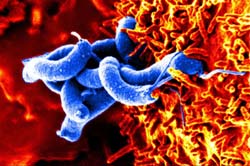Gene regulation: Can we stomach it?

Helicobacter pylori (blue) with cells of the intestinal epithelium (orange). Image: Brinkmann<br><br>
A breakthrough in decoding gene regulation of Helicobacter pylori has been made by an international research team led by Jörg Vogel of the Max Planck Institute for Infection Biology in Berlin. Using a newly developed sequencing technique, the re-searchers discovered 60 small ribonucleic acids (sRNAs) – tiny RNA-particles which can regulate genes – in the genome of this human pathogen. These findings could facilitate the development of new therapeutic strategies against this wide-spread pathogen. (Nature, February 17th 2010)
About 50 percent of the world’s population carry Helicobacter pylori (H. pylori) in their gastrointestinal tract – 30 percent of the German population are infected. Besides cancer, these bacteria are linked to other chronic diseases such as cardiovascular disease. The decoding of the H. pylori genome in 1997 revealed this pathogen to possess surprisingly few genes for transcriptional regulators, sparking a number of crucial questions: Where do the genes of Helicobacter start, and how are these switched on and off? Have all genes been discovered already?
Researchers have been searching for new types of gene regulators in this pathogen, especially for sRNAs. It has recently been realized that these tiny RNA particles are far more abundant in all organisms than previously thought. They can regulate genes by binding to sequences of the genetic information, thereby inhibiting the production of a protein. Yet strangely enough, sRNAs seemed to be lacking in Helicobacter. Jörg Vogel, leader of the RNA Biology Group at the Max Planck Institute for Infection Biology, and his team have finally tracked down a number of sRNAs in the pathogen. To enable their discovery, they modified a technique called “deep sequencing”, to decipher millions of RNA-sequences newly produced in a cell. The surprised scientists found 60 sRNAs: “To date, it was believed that this organism completely lacks sRNAs”, says Vogel.
A new model for gene regulation?
“We found as many sRNAs in Helicobacter as in widespread intestinal bacteria like Escherichia coli or Salmonella”, explains Vogel. But a very important protein required for the regulation of gene expression by sRNAs is missing in Helicobacter pylori. The stomach pathogen possibly uses different signalling pathways, which makes it a possible candidate as a model in RNA-research. “We hope to get completely new insights into gene regulation”, says Vogel.
Thanks to the novel technique, the researchers could also define the starting point of every gene in Helicobacter. “It enables us to interpret the genome in a completely new way”, explains Vogel. This success, achieved in collaboration with scientists from Leipzig (Germany) and Bordeaux (France), could facilitate the development of a vaccine against the pathogen. Vogel’s team will now apply the new sequencing technique to other food-borne pathogens. Interesting candidates are Campylobacter jejuni, which besides Salmonella is the most frequent cause for infectious diarrhoea.
Original work:
Cynthia M. Sharma, Steve Hoffmann, Fabien Darfeuille, Jérémy Reignier, Sven Findeiß, Alexandra Sittka, Sandrine Chabas, Kristin Reiche, Jörg Hackermüller, Richard Reinhardt, Peter F. Stadler & Jörg Vogel
The primary transcriptome of the major human pathogen Helicobacter pylori
Nature, Februar 17th 2010 online publication (doi: 10.1038/nature08756)
Contact:
Prof. Jörg Vogel
Max Planck Institute for Infection Biology, Berlin
Tel.: +49 (0)30 / 28460-265 / +49 (0)160 / 700-6532
E-mail: vogel@mpiib-berlin.mpg.de
Gesa Krey
Max Planck Institute for Infection Biology, Berlin
Tel.: +49 (0)30 / 28460-206
E-mail: Gesa.Krey@mpiib-berlin.mpg.de
Media Contact
More Information:
http://www.mpg.de/english/All latest news from the category: Life Sciences and Chemistry
Articles and reports from the Life Sciences and chemistry area deal with applied and basic research into modern biology, chemistry and human medicine.
Valuable information can be found on a range of life sciences fields including bacteriology, biochemistry, bionics, bioinformatics, biophysics, biotechnology, genetics, geobotany, human biology, marine biology, microbiology, molecular biology, cellular biology, zoology, bioinorganic chemistry, microchemistry and environmental chemistry.
Newest articles

Superradiant atoms could push the boundaries of how precisely time can be measured
Superradiant atoms can help us measure time more precisely than ever. In a new study, researchers from the University of Copenhagen present a new method for measuring the time interval,…

Ion thermoelectric conversion devices for near room temperature
The electrode sheet of the thermoelectric device consists of ionic hydrogel, which is sandwiched between the electrodes to form, and the Prussian blue on the electrode undergoes a redox reaction…

Zap Energy achieves 37-million-degree temperatures in a compact device
New publication reports record electron temperatures for a small-scale, sheared-flow-stabilized Z-pinch fusion device. In the nine decades since humans first produced fusion reactions, only a few fusion technologies have demonstrated…





















